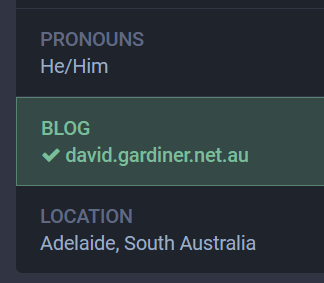-
Logitech MX Vertical Advanced Ergonomic Mouse
Many years ago, I was working at UniSA developing software. I tended to grind my wrist into the desk as I moused, and over time my wrist and hand became quite sore. UniSA was quite proactive with occupational health and safety, and I had an OH&S consultant visit me in my office. She suggested resting my right hand as much as possible, using a wrist rest, and trying out different-styled mice. For a few months, I switched to mousing with my left hand. I acquired a mouse mat with a gel wrist rest, and I also trialled a trackball mouse. The trackball didn't work out for me, but since then I've continued to use a gel wrist rest for both the mouse and keyboard.
So it was a bit of a surprise when the discomfort returned a few months ago. I used a similar approach of switching to my left hand to give my right hand a break, but I realised that would only be a temporary solution.
Asking for suggestions from my SixPivot colleagues, Logitech mice were frequently mentioned. With its unusual shape, intended to fit your hand at a more comfortable angle, I decided to give the Logitech MX Vertical Advanced Ergonomic mouse a go. Spending more than $100 on a mouse may seem a little extravagant, but if it would reduce the discomfort I'd been experiencing, it would be worth it.
The mouse is certainly different. The 'sculpted' curve is covered in a rubber-like material, so it grips nicely.

One thing I'd read about was that it was easy to knock over. It is true, I've accidentally whacked it several times and tipped it over. Probably because it sits higher (almost reminiscent of a tiny Sydney Opera House), so if you are liable to be waving your hands around that's something to consider!

It has the usual left and right mouse buttons and a scroll wheel. It took me a little while to get comfortable scrolling on the side, but I don't think about it now.

There are some other buttons near your thumb that some people might take advantage of, but I have yet to use them.

Likewise, there's a button on the top, that allows you to change the pointer speed. I can't say I've used that yet either.

One feature I didn't consider initially but do make use of now is that you can pair it to up to 3 computers and toggle between them via a small button on the base. In my day job, I may have a customer laptop in addition to my regular laptop. While I might use a tool like Mouse Without Borders to share a keyboard and mouse between the two, if I just want to use one laptop it's a quick button press to use the mouse with that device.

The mouse has a USB-C port that is used for charging as well as making the mouse usable as a USB mouse if you didn't want to use Bluetooth. It seems to hold a charge for quite a few weeks if not months - probably depends on your usage.
You can pair the mouse with Windows and it just works. Optionally you can install Logitech software which lets you customise how the different buttons work.
I've been using the mouse now for a few months and have grown to really like it. I'm pleased that the discomfort in my hand has reduced.
Recommended! (Affiliate links)
-
Elgato Green Screen MT
When I do presentations from home I like to have a non-distracting background. For a while, I was using a really old movie projector screen that originally belonged to my grandfather! The kind that is on a stand with tripod legs, it was getting on in years, and required a pair of multigrip pliers to hold the screen in place! I was just waiting for the day the pliers would fall off and the screen collapse mid-presentation, but thankfully that never happened!
It also needed to be packed away in my shed when I didn't need it. So I started to think about getting something more fit for purpose, that could be built into the room where I work from. Enter the Elgato Green Screen MT!

The screen itself is 2 metres wide and 1.8m high (the actual mounting points are 2.12 metres apart), and it is intended to be mounted on a wall or ceiling. I chose to do the latter, but after using a stud-finder I determined that my ceiling joists were not the same width apart as the screen. To compensate for that, I used light-gauge chains to join the screen to the hooks.

I took a lot of care to measure out how far back from my desk the screen should sit; so that I'd have enough room to sit in front of it, but also to try and avoid gaps showing in the video feed past the sides of the screen.

Now, most of the time the screen is retracted/up, but if I have a meeting or a presentation, then I can pull down the screen. Even more so in the evening, as our TV is in the same room so I can participate in the meeting online, while family members can still watch the TV without accidentally ending up on the video feed.

If you're thinking about buying a green screen, this week is a good one to do it with the price discounted.
Check it out online (affiliate links)
-
Hello Mastadon, not quite goodbye Twitter
Twitter has been going through a great upheaval over the last few weeks, with a new owner and now 50% less staff. Hopefully, it can survive this difficult time, but just to put an egg in another basket, I've created an account over at Mastodon.

My account is https://mastodon.online/@DavidRGardiner, which can also be represented as
@[email protected]Mastodon is kind of like Twitter, but kind of isn't. The most obvious difference is that it is distributed. In fact, in many ways thinking about it like email (where there are lots of email hosts that all talk to each other) rather than a single centralized, commercial social media company like Twitter, can be helpful. The account names even have an 'email address' look about them.
I could go into more detail, but there's already a great introduction over at https://github.com/joyeusenoelle/GuideToMastodon/#an-increasingly-less-brief-guide-to-mastodon
I'm not sure if I'll stay on the
mastodon.onlineserver. I've noticed quite a few Australian folks are choosingaus.social, though probably because of that, the server is struggling a bit under load. The nice thing is that it is possible to move your account between servers and I believe it redirects everything to your new location.If you're thinking of signing up, you might like to use instances.social to help you choose the best server for you. I only found out about this today, otherwise I might have used it myself! Having said that, I don't see
aus.socialon it, so I'm not sure how comprehensive it is.Verified
There's no 'blue tick' in Mastodon, but you can verify that a website you've added to your account profile is actually owned by you by adding a
rel=melink. I've done this to my blog in a couple of ways:- In the
<head>section I've added<link rel="me" href="https://mastodon.online/@DavidRGardiner" /> - In the footer, the links to my social profiles now include Mastodon, and links to
<a rel="me" href="https://mastodon.online/@DavidRGardiner" title="DavidRGardiner">
Mastodon recognises the
rel=meand shows a tick when you view my profile:
I was never verified on Twitter (I'm not that important, so wasn't really bothered!), and am unlikely to pay for the privilege, given it sounds like Twitter will be charging for that going forward.
Finding my Twitter friends
Finding people on Mastodon is complicated by the fact that if they're not on the same server as you, there's no built-in way to figure out where they are. The best you can do is by looking at the profiles of people you do know, and see who they are following, but that only gets you so far.
There are a couple of free services that I've utilised that can help with this:
Moa
Head over to Twitodon and sign in with your Twitter and Mastodon accounts. Moa keeps a record of other users who have already done this and then lets you download a CSV of any Mastodon users it knows about that are in your list of Twitter following.
You can go back later to see if any new folks have signed in to Twitodon that you know.
Fedifinder
Fedifinder will search all your Twitter following and looks for specific text in their profiles that is likely to be a Mastodon account. To make this work so that others can find me, I added my Mastodon account to my Twitter profile.

Cross-posting
I really hope Twitter hangs in there. You can keep a foot in each camp with a 'bridge' like Moa. I've set it up so anything I post to Twitter will be also posted to Mastodon. I've chosen not to enable the reverse.

Conclusion
So as long as Twitter remains useful I'll stick with it, but I'm now also on Mastodon and I'm curious to see how this alternate social media site pans out. Maybe I'll see you there!
- In the